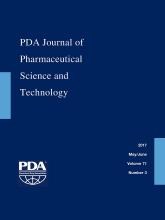Abstract
In this case study, the principles of quality risk management were applied to review sampling points and monitoring frequencies in the hormonal tableting unit of a formulation development pilot plant. In the cleanroom area, premises of different functions are located. Therefore a general method was established for risk evaluation based on the Hazard Analysis and Critical Control Points (HACCP) method to evaluate these premises (i.e., production area itself and ancillary clean areas) from the point of view of microbial load and state in order to observe whether the existing monitoring program met the emerged advanced monitoring practice.
LAY ABSTRACT: In pharmaceutical production, cleanrooms are needed for the manufacturing of final dosage forms of drugs—intended for human or veterinary use—in order to protect the patient's weakened body from further infections. Cleanrooms are premises with a controlled level of contamination that is specified by the number of particles per cubic meter at a specified particle size or number of microorganisms (i.e. microbial count) per surface area. To ensure a low microbial count over time, microorganisms are detected and counted by environmental monitoring methods regularly. It is reasonable to find the easily infected places by risk analysis to make sure the obtained results really represent the state of the whole room. This paper presents a risk analysis method for the optimization of environmental monitoring and verification of the suitability of the method.
Footnotes
Note: The views expressed in this paper are those of the authors and should not be considered the opinion of any authority or of Gedeon Richter Plc.
- © PDA, Inc. 2017
PDA members receive access to all articles published in the current year and previous volume year. Institutional subscribers received access to all content. Log in below to receive access to this article if you are either of these.
If you are neither or you are a PDA member trying to access an article outside of your membership license, then you must purchase access to this article (below). If you do not have a username or password for JPST, you will be required to create an account prior to purchasing.
Full issue PDFs are for PDA members only.
Note to pda.org users
The PDA and PDA bookstore websites (www.pda.org and www.pda.org/bookstore) are separate websites from the PDA JPST website. When you first join PDA, your initial UserID and Password are sent to HighWirePress to create your PDA JPST account. Subsequent UserrID and Password changes required at the PDA websites will not pass on to PDA JPST and vice versa. If you forget your PDA JPST UserID and/or Password, you can request help to retrieve UserID and reset Password below.






